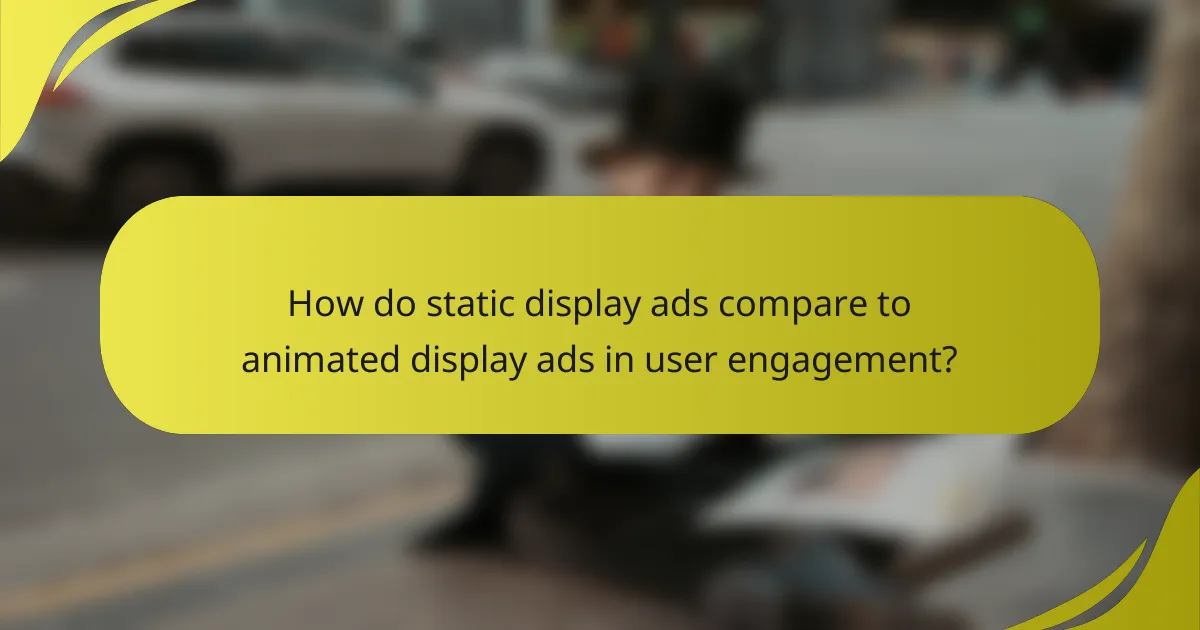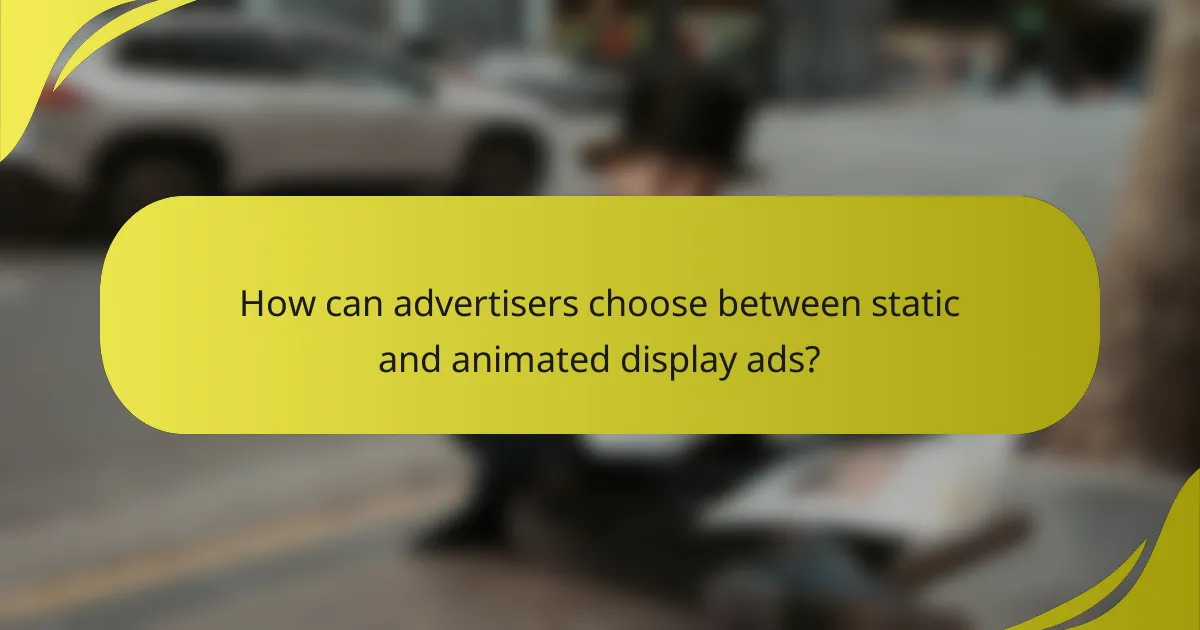In the realm of digital advertising, the choice between static and animated display ads significantly impacts user engagement and brand messaging. While static ads provide clarity and straightforward communication, animated ads are designed to capture attention and foster interaction, making them increasingly popular among marketers. Understanding the nuances of each format can help advertisers tailor their strategies for maximum effectiveness and user response.

How do static display ads compare to animated display ads in user engagement?
Static display ads generally have lower user engagement compared to animated display ads. While static ads can effectively convey a message, animated ads tend to capture more attention and encourage interaction, making them a preferred choice for many marketers.
Static ads have lower engagement rates
Static ads typically experience lower engagement rates, often falling in the single-digit percentage range for click-through rates. Users may overlook these ads due to their lack of movement and dynamic content, leading to less interaction. This can be particularly evident in competitive markets where visual stimulation is key to capturing attention.
Marketers should consider the context in which static ads are displayed. For instance, in environments where users are scrolling quickly, static ads may struggle to stand out, resulting in missed opportunities for engagement.
Animated ads capture more attention
Animated ads are designed to be visually stimulating, often resulting in higher engagement rates compared to their static counterparts. By incorporating movement and transitions, these ads can draw the viewer’s eye and encourage them to interact. Studies have shown that animated ads can achieve click-through rates that are significantly higher than static ads.
However, the effectiveness of animated ads can vary based on the execution. Ads that are overly complex or distracting may lead to viewer fatigue, so it’s essential to strike a balance between creativity and clarity.
Static ads are easier to produce
Producing static ads is generally simpler and more cost-effective than creating animated ads. Static ads require less design time and fewer resources, making them a practical choice for businesses with limited budgets or tight deadlines. A well-designed static ad can still convey a strong message without the need for animation.
For businesses looking to quickly test different messages or visuals, static ads allow for rapid iterations. This can be particularly beneficial in campaigns where timely responses to market trends are crucial.
Animated ads can convey more information
Animated ads have the advantage of conveying more information in a shorter amount of time. Through movement, these ads can illustrate processes, showcase product features, or tell a story that engages viewers more effectively than static images. This capability can lead to a deeper understanding of the product or service being advertised.
When designing animated ads, it’s important to focus on clarity and pacing. Overloading viewers with too much information or rapid transitions can detract from the message. A well-crafted animated ad should guide the viewer through the content smoothly, ensuring that key points are easily digestible.

What is the impact of static vs. animated display ads on brand awareness?
Static and animated display ads both play significant roles in enhancing brand awareness, but they do so in different ways. Animated ads tend to capture attention more effectively, while static ads often convey messages more clearly and concisely.
Animated ads increase brand recall
Animated display ads are designed to engage viewers through movement and dynamic content, which can significantly enhance brand recall. Research indicates that consumers are more likely to remember brands associated with eye-catching animations compared to static images.
For effective animated ads, consider using brief animations that highlight key brand messages or features. Aim for a duration of around 15 to 30 seconds to maintain viewer interest without overwhelming them.
Static ads provide clear messaging
Static display ads excel in delivering straightforward messages without distractions. They allow brands to present their value propositions clearly, making it easier for consumers to grasp the intended message quickly.
When designing static ads, focus on strong visuals and concise text. Use bold headlines and a clear call to action to guide viewers. A well-placed logo can also reinforce brand identity, ensuring that the message resonates even after the ad is no longer visible.

What factors influence user response to display ads?
User response to display ads is influenced by several factors, including ad format, targeting strategies, and the overall user experience. Understanding these elements can help advertisers optimize their campaigns for better engagement and effectiveness.
Ad format affects click-through rates
The format of display ads plays a crucial role in determining click-through rates (CTR). Static ads generally have lower CTRs compared to animated ads, which can capture attention more effectively through movement and visual interest.
For example, animated ads can increase engagement by showcasing multiple products or messages in a single ad unit. However, they should be designed carefully to avoid overwhelming users, as excessive animation can lead to annoyance and reduced effectiveness.
Targeting impacts user engagement
Effective targeting significantly enhances user engagement with display ads. By utilizing data-driven insights to reach specific demographics, advertisers can tailor their messages to resonate with the intended audience, leading to higher interaction rates.
For instance, targeting based on user behavior or interests can yield better results than broad demographic targeting. Advertisers should consider using retargeting strategies to reach users who have previously interacted with their brand, as this can lead to increased conversion rates.

How can advertisers choose between static and animated display ads?
Advertisers can choose between static and animated display ads by considering their campaign goals, understanding their target audience, and evaluating budget constraints. Each ad type has unique strengths that can align with specific marketing objectives.
Consider campaign objectives
When selecting between static and animated display ads, the campaign’s objectives play a crucial role. Static ads are often effective for straightforward messages and brand awareness, while animated ads can enhance storytelling and engagement for more complex campaigns.
For example, if the goal is to promote a new product launch, animated ads may capture attention better through motion and visuals. Conversely, if the aim is to reinforce brand identity, a simple static ad may suffice.
Evaluate target audience preferences
Understanding the preferences of the target audience is essential in choosing the right ad format. Younger demographics may respond more positively to animated ads, which can convey energy and excitement, while older audiences might prefer the clarity and simplicity of static ads.
Conducting surveys or analyzing past campaign performance can provide insights into what resonates with your audience. Tailoring the ad format to audience preferences can significantly enhance engagement rates.
Assess budget constraints
Budget constraints are a critical factor in deciding between static and animated display ads. Animated ads typically require more resources for design and production, which can increase costs significantly compared to static ads.
Advertisers should evaluate the potential return on investment (ROI) for each ad type. If the budget is limited, focusing on high-quality static ads may yield better results than a poorly executed animated ad. Prioritizing quality over quantity is key in maximizing impact within budget limits.

What are the best practices for creating effective display ads?
Effective display ads should capture attention quickly and encourage user interaction. Key practices include using clear calls to action, optimizing for mobile devices, and testing different formats to find what resonates best with your audience.
Use clear calls to action
Clear calls to action (CTAs) are essential for guiding users toward the desired action, such as clicking a link or making a purchase. Use concise, action-oriented language like “Shop Now” or “Learn More” to create urgency and clarity.
Position your CTAs prominently within the ad, ensuring they stand out visually. Consider using contrasting colors and larger fonts to draw attention, making it easy for users to identify the next step.
Optimize for mobile devices
With a significant portion of web traffic coming from mobile devices, optimizing display ads for smaller screens is crucial. Ensure that your ads are responsive, meaning they adjust seamlessly to various screen sizes and orientations.
Keep text concise and visuals simple to enhance readability on mobile. Test your ads on different devices to confirm that they load quickly and maintain visual appeal, as slow-loading ads can lead to high bounce rates.
Test different formats
Experimenting with various ad formats can help identify which ones yield the best engagement. Consider testing static images, animated graphics, and video ads to see how each performs with your target audience.
Use A/B testing to compare different designs, messaging, and placements. Analyze metrics such as click-through rates and conversion rates to determine the most effective format for your campaign goals.

What tools can help in designing display ads?
Several tools can assist in designing effective display ads, each catering to different needs and skill levels. Popular options include Canva for static ads and Adobe Animate for animated ads, providing user-friendly interfaces and a variety of features to enhance ad creativity.
Canva for static ads
Canva is an intuitive graphic design tool that allows users to create static display ads easily. It offers a wide range of templates tailored for various platforms, making it suitable for both beginners and experienced designers.
When using Canva, consider the dimensions required for your ad, as different platforms have specific size guidelines. For example, a common size for web banners is 728 x 90 pixels. Canva’s drag-and-drop functionality simplifies the design process, enabling quick adjustments and customization.
To maximize engagement, focus on clear messaging and visually appealing elements. Avoid clutter and ensure that your call-to-action stands out, as this can significantly influence user response.
Adobe Animate for animated ads
Adobe Animate is a powerful tool for creating animated display ads that capture attention through movement and interactivity. It allows designers to create rich animations and export them in various formats suitable for web use.
When designing animated ads, keep in mind the importance of file size and loading speed. Aim for animations that are smooth yet lightweight, ideally under 150 KB, to ensure quick loading times and a better user experience. Adobe Animate provides various features like timeline control and motion presets to streamline the animation process.
Consider the balance between animation and message clarity. While animations can enhance engagement, they should not distract from the ad’s primary message. A well-placed call-to-action within the animation can guide users effectively towards the desired action.

What are the emerging trends in display advertising?
Emerging trends in display advertising focus on enhancing user engagement through innovative formats and personalized content. Advertisers are increasingly leveraging data-driven insights to create more impactful ads that resonate with target audiences.
Static Display Ads
Static display ads are simple, non-moving advertisements that typically feature images and text. They are straightforward and can effectively convey a message without distractions, making them suitable for brand awareness campaigns.
When designing static ads, clarity is crucial. Use bold visuals and concise messaging to capture attention quickly. A good practice is to maintain a consistent brand identity across all static ads to reinforce recognition.
Animated Display Ads
Animated display ads incorporate motion elements, which can significantly enhance user engagement. These ads often tell a story or highlight key features through transitions, making them more visually appealing.
However, it’s essential to balance animation with load times. Ads that are too complex may frustrate users, leading to higher bounce rates. Aim for animations that are smooth and quick, ideally loading in low tens of milliseconds.
Engagement and User Response
Engagement levels can vary significantly between static and animated ads. Animated ads generally see higher click-through rates due to their dynamic nature, but they may also incur higher production costs.
To optimize user response, consider A/B testing both ad types. This approach allows you to gather data on which format resonates more with your audience, helping you allocate your advertising budget more effectively.
Impact on Brand Awareness
Both static and animated display ads can boost brand awareness, but their effectiveness often depends on the target audience and campaign goals. Static ads may work better for straightforward messaging, while animated ads can create a memorable experience.
When measuring impact, track metrics such as impressions, clicks, and conversions. This data will help you understand how each ad type contributes to overall brand visibility and user engagement.



